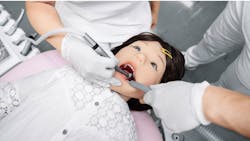H&P Insights is a new column recapping some of the trends and highlights from Hydraulics & Pneumatics editors.
The 50-Cent Problem
At its most recent virtual quarterly conference, the National Fluid Power Association (NFPA) and the Fluid Power Industrial Consortium (FPIC) focused on pneumatic power, with Jeremy King, product manager at IMI Precision Engineering leading a discussion on using condition monitoring to improve pneumatic efficiency.
One of the more interesting observations from King was that while all monitoring has value, it’s very often the more basic components that can be overlooked in the monitoring effort. “As you start thinking about lifecycle, you want to look at which devices on your machines are going to cause the biggest problems,” King told the audience. “If the 50-cent suction cup stops you from picking stuff up, that’s going to be a problem.” King said that in developing a comprehensive plan, it’s important to look at the points of failure and the probability of failure in developing a comprehensive plan. The robot arm may be the piece with the greatest capital investment, but if a cylinder or suction cup fails, it’s just as costly to the operation.
The next NFPA/FPIC regional conference is June 3, and that is scheduled to be another virtual event. After that, the group is cautiously looking forward to reconvening live events again.
It’s International Women’s Day
March 8 marks International Women’s Day, and the organizers of the day ask, “How will you forge a gender-equal world?” It’s a question which the engineering community continues to address.
Unfortunately, part of the issue is one of semantics. There is a linguistic difference between “women engineers” and “engineers who are women.” Because we don’t use the phrase “men engineers,” categorizing women in the field as a group apart in some way keeps them apart. We have to start by understanding that engineering is by nature a gender-neutral field. Your work is judged by your finished product.
But we have traditional biases, conscious and unconscious, and so there has been a greater effort in the last 20 years to help women see their place in engineers, and for engineering to do a better job of recruiting. There continues to be shortages of skilled workers in an increasingly digital age, and yet the Society for Women Engineers estimates only 13% of engineering jobs are held by women.
Some Days It’s Like Pulling Teeth
In order to help aspiring dentists better serve their squirmiest customers—small children—a robotic simulator has been developed that allows that squirminess to be replicated.
The Pedia Roid, is 3 ft., 6 in. tall and weighs about 50 lb, approximating the size of a five-year-old. Its lifelike movements are produced using proportional pressure regulators with piezo technology. It can perform 24 actions, including coughing, fidgeting, squirming, flinging and clenching teeth.
The use of robotics and pneumatics in tandem is nothing new, but the opportunity to create a lifelike version of a nervous child should lead to better dentistry. It will save time, money, angst and the cost of lollipops at the end of the visit.
About the Author
Bob Vavra
Senior Content Director, Power & Motion and Machine Design
Bob Vavra is the Senior Content Director of Power & Motion and its sister publication Machine Design. Vavra has had a long career in publishing, media and events. He has covered all aspects of manufacturing for the past 20 years and is a regular attendee at events such as IMTS and Hannover Messe. Vavra is also a sought-after webcast moderator and event emcee, and has presided over events in the U.S., Germany and China.

Leaders relevant to this article:
